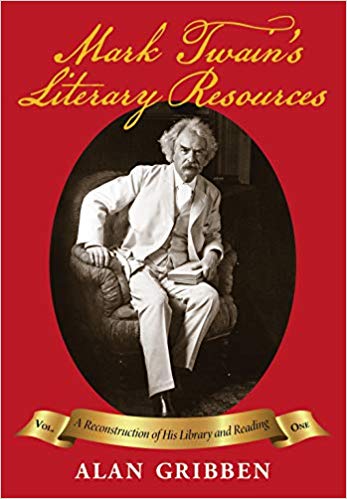Mark Twain’s Literary Resources: A Reconstruction of His Library and Reading
- By Alan Gribben
- NewSouth Books
- 328 pp.
- Reviewed by Philip K. Jason
- July 2, 2019
This astonishing portrait proves the iconic author was a committed bookworm.

The immense Mark Twain’s Literary Resources, requiring two more volumes for completion, is a model of disciplined, lively, and monumental literary scholarship. It is an expansion of Alan Gribben’s Mark Twain’s Library, originally published in 1980. This first effort was already a momentous work, but over the decades, new information has come to light that the author has now included, along with updated commentary. The additional volumes are expected later this year.
Though Samuel Clemens, as Mark Twain, often projected the persona of a somewhat noble savage, he was, in fact, a voracious book collector and reader, as well as a committed annotator of books.
He helped create libraries. He moved collections from one home to another. He lived in his books and was influenced by them. He learned about his world, past historical periods, literary classics, and the craft of writing through his adventures as a reader.
It is great fun to join Gribben as he puts us into this significant part of Twain’s life. While much of Gribben’s work is the bedrock business of fact-collecting, the delights come from his many ways of exploring for his readers what Twain’s collected reading means in understanding the classic American author as a man, a creative force, and as both an appreciator and detractor of the writings of others.
One strand of excitement for readers is Gribben’s discussion of Twain’s relationship with the eminent man of letters William Dean Howells, whose comments about Twain being an “unliterary” literary man held sway until they were slowly revealed to be false.
Twain himself enjoyed painting himself as an infrequent reader, but over decades the truth of his addiction to books — of many kinds — became indisputable. Why the charade? Was it to tamp down expectations?
First in his personal life, and later in his public life, Twain demonstrated a penchant for reading aloud. For him, the voicing of an author’s words was essential for full understanding and enjoyment. At his urging, he and his wife, Olivia, read to one another at the end of the day. Twain encouraged such activity in social settings at which he would frequently be the center. He was, more and more, a showman as well and an author, and his skills in both areas were complementary.
Twain was a popular lecturer and literary performer. His readings drew audiences, amplified as they were with comments on the text he voiced. Perhaps his favorite author to read aloud was Robert Browning, the study and performance of whose dramatic monologues may have helped Twain develop the right pattern of emphasis, pace, and tonality for creating the voices of his fictional characters.
In poetry and prose, he loved to find the “illusion of talk.” He worked hard at perfecting his deliveries, and what he learned in the process informed his own writings.
A fascinating chapter in Gribben’s book examines Twain’s interest in and mixed attitude toward the pseudoscience of phrenology. Although he tended to belittle this field of study, it nevertheless held for him, as did spiritualism, an ongoing interest. This interest is evident in The Adventures of Huckleberry Finn and elsewhere.
Twain’s Huck Finn and Tom Sawyer books are explored by Gribben in the context of the contemporary and popular “boy book,” which were in vogue during the later-19th and early-20th centuries. Twain owned many of them, including William Dean Howells' A Boy's Town and William Allen White’s The Court of Boyville. He also read, but might not have owned, Thomas Bailey Aldrich’s The Story of a Bad Boy. Gribben’s sojourn into the world of this fleeting genre is delicious reading, and his understanding of what this phenomenon may have meant to Twain is full of good sense and sensitivity.
Of great interest in the story of Twain’s books is the manner of collecting and housing books, the state of the bookselling industry, and the movement of books into and out of private and public collections. Twain’s own success as an author fed on being surrounded by the books of other writers and — in one way or another — drawing upon them for his own purposes. This is not to say that Twain was a plagiarist, but rather that he learned to adapt what he found in his reading for his own purposes.
What happened to all of these books? Part of the answer is found in Gribben’s last chapter: “The Unfortunate Fate of the Clemenses’ Library Collection,” which includes a reproduction of titles offered in a 1951 auction in Hollywood. A “Critical Bibliography” provides an annotated listing of published items “related to Samuel L. Clemens’s reading.”
Volume one, then, which presents all of Alan Gribben’s research on Twain’s reading, is an astonishing and captivating achievement. Volumes two and three will provide the annotated catalogue.
Philip K. Jason is professor emeritus of English at the United States Naval Academy. A former editor of Poet Lore magazine, he is the author or editor of 20 books, including Acts and Shadows: The Vietnam War in American Literary Culture and Don’t Wave Goodbye: The Children’s Flight from Nazi Persecution to American Freedom. His reviews appear in a wide variety of regional and national publications.

